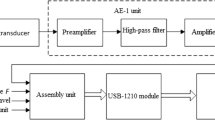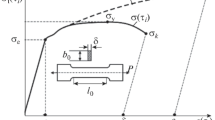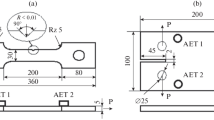Abstract
A technique for measuring the energy sensed at an acoustic-emission transducer is presented that utilizes a squaring circuit and digital integrator. Theoretical relationships between energy and other more conventional acoustic-emission parameters, such as counts and RMS voltage, are derived for certain idealized cases. Experimental results from the following types of tests are presented: (1) unflawed tensile (‘continuous’ emission); (2) precracked stress-corrosion cracking; (3) precracked fracture toughness; and (4) fatigue-crack growth. Energy, counts, RMS-voltage, energy/event and counts/event measurements are included. In the case of unflawed tensile specimens, energy techniques appeared somewhat superior to counts. In all other cases, a direct relationship between counts and energy was obtained. Energy measurements tended to give a larger weight to higher amplitude events. Other than this, energy measurements appeared to have no advantage over counts. The theoretical relationship predicted between energy/event and count/event agreed quite well with experimental observations. Overall, the test results presented indicate that energy techniques provide no significant advantage over counting threshold crossings in cases in which crack extension in metals is the primary source of acoustic emission.
Similar content being viewed by others
Abbreviations
- C :
-
a constant [see eq (3)]
- f :
-
frequency of oscillations in an acoustic-emission signal
- G n :
-
gain of amplifier chain to counter
- G u :
-
gain of amplifier chain to energy processor
- n :
-
counts for a single event
- N :
-
total acoustic-emission counts
- N :
-
acoustic-emission count rate
- N′:
-
acoustic-emission counts/load cycle
- P :
-
tensile load
- S :
-
value of RMS-voltage signal above background noise
- t :
-
time
- t n * :
-
time for acoustic-emission signal to counter to ring down below trigger level of counter
- t u * :
-
time for acoustic-emission signal to digital integrator in energy processor to ring down to trigger level of processor
- u :
-
energy for a single event
- U :
-
total acoustic-emission energy
- У:
-
energy rate/s, V2-s/s
- U′:
-
acoustic-emission energy/load cycle
- V(t) :
-
volts
- V o :
-
amplitude of continuous-emission signal
- V on :
-
initial amplified and filtered voltage from single event to counter
- V on :
-
initial amplified and filtered voltage from single event to energy processor
- V n :
-
amplified and filtered acoustic-emission signal to counter
- V u :
-
amplified and filtered acoustic-emission signal to energy processor
- V tn :
-
threshold voltage in counter
- V tu :
-
threshold voltage in energy processor
- ε:
-
tensile strain, percent
- τ:
-
decay time of acoustic-emission signal [see eq (3)]
References
Acoustic Emission, ASTM Special Tech. Pub. No. 505, ASTM, Philadelphia, PA (1972).
Dunegan, H.L. andTetelman, A.S., “Nondestructive Characterization of Hydrogen Embrittlement Cracking by Acoustic Emission Techniques,”Enrg. Fract. Mech.,2,387–402 (Jun. 1971).
Harris, D.O., Dunegan, H.L. and Tetelman, A.S., “Prediction of Fatigue Lifetime by Combined Fracture Mechnics and Acoustic Emission,” Proc. Air Force Conf. Fatigue and Fracture of Aircraft Structures and Materials, AFFDL Rep. AFFDL TR 70-144, 459–471 (1970).
Harris, D.O. andDunegan, H.L., “Continuous Monitoring of Fatigue Crack Growth by Acoustic-emission Techniques,”Experimental Mechanics,14 (2),71–81 (Feb. 1974).
Dunegan, H.L. andHarris, D.O., “Acoustic Emission Techniques,”Exper. Tech. Fract. Mech., Kobayashi, A.S., ed., SESA, Westport, CT, Ch. 3, 38–75 (1973).
Magnani, N.J., “Acoustic Emission and Stress-corrosion Cracking of U-4 1/2 wt. % Nb,” Experimental Mechanics,13 (12) (Dec. 1973).
Harris, D.O., Tetelman, A.S. andDarwish, F.A.I. “Detection of Fiber Cracking by Acoustic Emission,”Acoustic Emission, ASTM Special Tech. Pub., No. 505, ASTM, Philadelphia, PA, 238–249 (1972).
Brindley, B.J., Holt, J. andPalmer, I.G., “Acoustic Emission—3, The Use of Ringdown Counting,”Non-Destructive Testing,6,299–306 (Dec. 1973).
Dunegan, H.L. andGreen, A.T., “Factors Effecting Acoustic Emission Response from Materials,”Acoustic Emission, ASTM Special Tech. Pub. No. 505, ASTM, Philadelphia, PA, 100–113 (1972).
Hutton, P.H., “Acoustic Emission Applied Outside the Laboratory,”ibid, (1972)114–128.
Beattie, A.G. and Jaramillo, R.A., “The Measurement of Energy in Acoustic Emission,” Sandia Laboratories, Albuquerque, NM (undated).
Tetelman, A.S., “Acoustic Emission, and Fracture Mechanics Testing of Metals and Composites,” Materials Department, UCLA, No. UCLA-ENG-7249, presented U.S.-Japan Joint Symp. Acoustic Emission, Tokyo, Japan (Jul. 1972).
Hamstad, M.A. andMukherjee, A.K., “The Dependence of Acoustic Emission on Strain Rate in 7075-T6 Aluminum,”Experimental Mechanics,14 (1),33–41 (Jan. 1974).
Wessel, E.T., “State of the Art of the WOL Specimen for K Ic Fracture Toughness Testing,”Engrg. Fract. Mech.,1 (1),77–103 (Jun. 1968).
Johnson, H.H. andParis, P.C., “Subcritical Flaw Growth,”ibid., 3–46.
Bell, R.L., “Acoustic Emission Transducer Calibration—Transient Pulse Method,”Dunegan/Endevco Tech. Rep. No. DE-73-3, Dunegan/-Endevco, San Juan Capistrano, CA (Feb. 1973).
Harris, D.O., “The Effect of Gain and Frequency Bandpass on Acoustic Emission Observed from Growing Fatigue Cracks,” Dunegan/-Endevco Technical Report No. DE-74-4, San Juan Capistrano, CA (Jan. 1974). Presented at Symp. Schallemission Anwendung bei der Untersuchung, Prufung und Uberwachung metallischer Werkstoffe, sponsored by Deutsche Gesellschaft fur Metallkunde, Munich, Germany (Apr. 1974).
Author information
Authors and Affiliations
Additional information
D.O. Harris and R.L. Bell were associated with Dunegan/Endevco at time that paper was prepared
Rights and permissions
About this article
Cite this article
Harris, D.O., Bell, R.L. The measurement and significance of energy in acoustic-emission testing. Experimental Mechanics 17, 347–353 (1977). https://doi.org/10.1007/BF02326321
Received:
Revised:
Issue Date:
DOI: https://doi.org/10.1007/BF02326321




